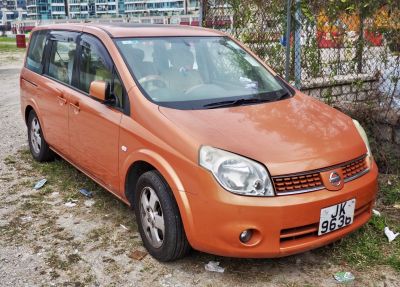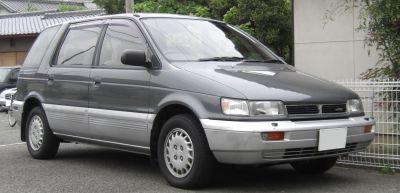 1999 Mitsubishi Santamo Dimensions, Size & Specs
1999 Mitsubishi Santamo Dimensions, Size & Specs
Measurements of the 1999 Mitsubishi Santamo, engineered for optimal performance and comfort
| Dimensions | |
|---|---|
| Length: | 4515 mm177.8 in14.8 ft |
| Width: | 1695 mm66.7 in5.6 ft |
| Height: | 1620 mm63.8 in5.3 ft |
| Trunk Capacity: | 212 liter7.5 cu ft |
| Trunk Capacity (Max): | 1714 liter60.5 cu ft |
| Weight Specifications | |
| Curb Weight: | 1450-1540 kg3197-3395 lbs |
| Maximal permitted Weight: | 2070 kg4564 lbs |
| Tire Specifications | |
| Rims Size: |
|
| Tire Sizes: |
|
The Mitsubishi Santamo, produced from 1999 to 2004, is a versatile minivan designed to meet the needs of families seeking practicality and comfort. Featuring a length of 4515 mm (177.6 inches), a width of 1695 mm (66.7 inches), and a height of 1620 mm (63.8 inches), the Santamo offers a spacious exterior profile that fits well within the compact minivan segment. The curb weight ranges between 1450 to 1540 kg (3197 to 3397 lbs), providing a stable and manageable driving experience. Structurally built to handle a maximum weight of 2070 kg (4563 lbs), the vehicle is suitable for carrying passengers and cargo efficiently. Its luggage capacity stands at 212 liters (7.5 cubic feet) with all seats in place, expanding significantly to 1714 liters (60.5 cubic feet) when the rear seats are folded down, catering to larger storage needs. The Santamo rides on 14-inch rims fitted with tires sized 185/70 R14, available with speed ratings of H and T, balancing handling and comfort. This combination of dimensions and capacities makes the Mitsubishi Santamo a practical option for families and users requiring flexible space and reliable road presence in the minivan category.
Discover the standout features that make the 1999 Mitsubishi Santamo a leader in its class
Have a question? Please check our knowledgebase first.
The Mitsubishi Santamo from 1999 to 2004 measures 4515 mm (177.6 inches) in length, 1695 mm (66.7 inches) in width, and 1620 mm (63.8 inches) in height. These dimensions make it a compact minivan, ideal for urban environments with relatively easy maneuverability and manageable parking. Its length is moderate for a minivan, balancing interior room with the ability to navigate urban streets efficiently. The relatively narrow width of 1695 mm contributes to easier lane changes and driveway entry. The height allows for ample headroom inside, enhancing comfort for passengers while maintaining a profile that isn’t too tall for typical city infrastructure like parking garages.
The Mitsubishi Santamo offers a luggage capacity of 212 liters (7.5 cubic feet) with all rear seats in place, suitable for everyday groceries or small luggage. When the rear seats are folded, the cargo space dramatically increases to 1714 liters (60.5 cubic feet), providing substantial room for larger cargo or bulky items. This flexibility makes the Santamo a practical choice for families and individuals who require adaptable storage for varied needs, from daily commuting to longer trips involving more luggage or equipment.
Yes, the Mitsubishi Santamo is well suited for standard residential garages. With a width of 1695 mm (66.7 inches) and height of 1620 mm (63.8 inches), it fits comfortably within the typical garage door openings which generally measure about 2400 mm (94.5 inches) wide and 2100 mm (82.7 inches) high. Its length of 4515 mm (177.6 inches) can also be accommodated by most single-car garage lengths which typically start from 4800 mm (189 inches). Thus, garage parking at home will be convenient without requiring special accommodations.
The curb weight of the Mitsubishi Santamo ranges between 1450 kg and 1540 kg (3197 to 3398 pounds), which places it on the lighter side compared to other minivans from the late 1990s to early 2000s. This relatively moderate weight helps with fuel efficiency, handling, and daily drivability, while still maintaining sturdiness and safety. Many competitors of that period weighed more, sometimes exceeding 1600 kg (3527 pounds), due to larger size or heavier materials. The Santamo strikes a balance between being robust and light enough for nimble performance.
The Mitsubishi Santamo comes with 14-inch rims equipped with tires sized 185/70 R14 H or 185/70 R14 T. These moderately sized wheels provide a good balance between comfort and handling. The tire width of 185 mm and aspect ratio of 70 offers a cushioned ride over bumps and rough road surfaces while maintaining responsive handling characteristics. The tire ratings H and T reflect the speed capabilities of the tires, with H being suitable up to 210 km/h (130 mph) and T up to 190 km/h (118 mph). Overall, this setup supports stable and secure driving at typical minivan speeds.
The Mitsubishi Santamo has a maximum weight capacity of 2070 kg (4562 pounds), which includes the vehicle’s curb weight and the load it can carry including passengers and luggage. This relatively high maximum weight ensures that the minivan can accommodate full passenger loads—typically 5 to 7 people depending on configuration—along with their cargo without compromising safety or performance. For families, this capacity means the Santamo can handle school runs, road trips, and daily errands without stressing its mechanical components or safety systems.
The Mitsubishi Santamo introduced in 1999 represented a size and design modernizing step compared to earlier related models like the Mitsubishi Space Wagon. Dimensionally, the Santamo at 4515 mm in length and 1695 mm in width is compact yet spacious in comparison, optimized for mid-size family use. The height at 1620 mm offers improved headroom versus some predecessors. This generation focused more on maximizing interior space with clever packaging, while refining the exterior proportions to be more aerodynamic and urban-friendly, representing a clear evolution in both comfort and usability.
The Mitsubishi Santamo was competitive in the minivan segment of its time, offering a compact footprint with smart interior packaging. Compared to rivals like the Renault Scenic, Citroën Evasion, or Volkswagen Sharan, it generally had a slightly smaller width but comparable length and height, making it more maneuverable in city environments. While its luggage capacity of 212 liters (expandable to 1714 liters) was competitive, some rivals offered more flexible seating arrangements or slightly larger cargo volume. The Santamo’s modest curb weight and efficient use of space made it a practical and economical choice in its class.
The Mitsubishi Santamo is designed as a family-friendly minivan, typically seating 5 to 7 passengers depending on the interior configuration. The relatively tall height of 1620 mm (63.8 inches) ensures generous headroom for all occupants. While specific interior length and width are not detailed here, its overall external dimensions combined with smart seat layout provide ample legroom and shoulder space appropriate for its class. The flexible rear seating system allows for easy folding to expand cargo capacity, enhancing passenger comfort and utility.
The Mitsubishi Santamo’s moderate length (4515 mm or 177.6 inches) and width (1695 mm or 66.7 inches), combined with a curb weight ranging between 1450 and 1540 kg (3197 to 3398 pounds), contribute positively to its fuel efficiency and handling characteristics. The vehicle’s size is optimized to provide enough interior space without excessive bulk, which aids in lowering aerodynamic drag and rolling resistance. Its relatively light weight helps in maintaining better fuel economy and agile handling, especially important for a family minivan. Overall, these dimensions promote a balance between spaciousness, comfort, and driving economy.
Discover similar sized cars.

| Production: | 2004-2007 |
|---|---|
| Model Year: | 2005 |
| Length: | 4495 mm177.0 in |
| Width: | 1695 mm66.7 in |
| Height: | 1615 mm63.6 in |

| Production: | 1998-2003 |
|---|---|
| Model Year: | 1998 |
| Length: | 4515 mm177.8 in |
| Width: | 1695 mm66.7 in |
| Height: | 1580 mm62.2 in |

| Production: | 1991-1998 |
|---|---|
| Model Year: | 1991 |
| Length: | 4515 mm177.8 in |
| Width: | 1695 mm66.7 in |
| Height: | 1615-1630 mm63.6-64.2 in |

| Production: | 1991-1997 |
|---|---|
| Model Year: | 1991 |
| Length: | 4515 mm177.8 in |
| Width: | 1695 mm66.7 in |
| Height: | 1580-1595 mm62.2-62.8 in |
